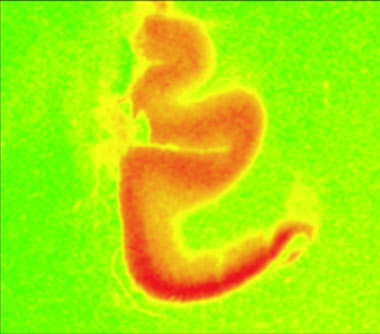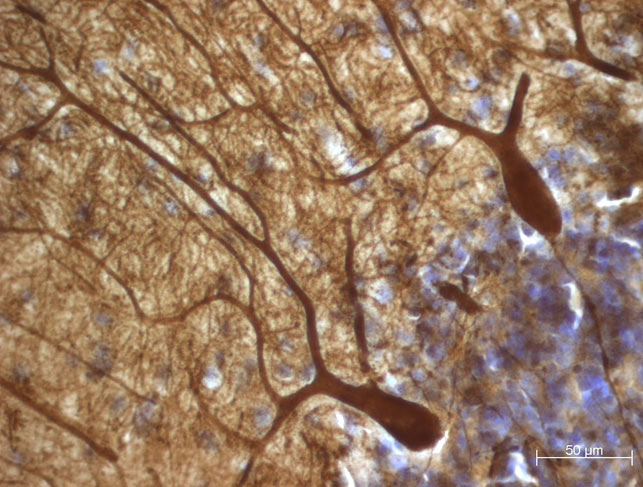Autism Neurocircuitry Laboratory: Neurochemistry
Gene J. Blatt, Ph.D., Director of Neuroscience / Senior Investigator

Control

[3H]-Muscimol labeled GABAA receptors in the posterior cingulate cortex. Red-orange indicates a high density of label, yellow-green indicates, low density binding. Note: The significant decrease in GABAA receptors in the Autism Case.
The main goal of the Autism Neurocircuitry Laboratory is to determine how the imbalance of excitation and inhibition in specific areas and regions in the autism brain impacts connectivity and ultimately function. Experiments are designed to collectively evaluate local and long range circuitry in efforts to better understand how altered connectivity within and among areas contributes to altered sensorimotor and cognitive processing.
To accomplish this, our laboratory utilizes a wide array of methods investigating the neuropathological and neurochemical basis of autism. Fresh-frozen and fixed tissue sections from individuals with autism and matched controls from a variety of cortical and subcortical brain areas are used in the studies. Standard Nissl stains delineate cytoarchitectural features of brain areas. Stereological principles are used for neuronal counts utilizing Stereoinvestigator software. Immunocytochemical methods are used to immuno-label GABAergic, glutamatergic and other biomarkers on specific cell types and fibers. In collaboration with Dr. Jean-Jacques Soghomonian, in situ hybridization histochemistry is performed to label mRNA expression of key synthesizing enzymes and receptor subtypes. Ligand binding autoradiography is utilized to label the density and distribution and/or number of different types of neurotransmitter uptake sites and receptors. Collectively, these experiments will determine how differences in excitatory and inhibitory markers in the autism brain contribute to altered information processing and its relation to behavior.

Purkinje cells (PCs) immunostained with calbindin. PCs are reduced in number within postmortem cerebella in many patients with autism.
Lab Team
Gene J. Blatt, Ph.D.
Director of Neuroscience / Senior Investigator
Cheryl Brandenburg, M.S.
Senior Research Assistant & Laboratory Coordinator, Hussman Institute for Autism
Brittany White
Research Technician, Hussman Institute for Autism
Charity Ensor
Research Technician, Hussman Institute for Autism
Contact Information
Gene J. Blatt, Ph.D.
Director of Neuroscience / Senior Investigator
Autism Neurocircuitry Laboratory
Program in Neuroscience
801 W. Baltimore Street / Suite 301
Baltimore, MD 21201
443.860.2580 ext. 730
gblatt@hussmanautism.org
